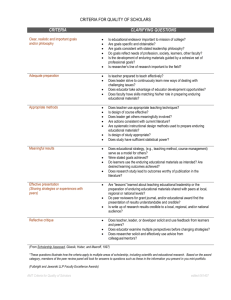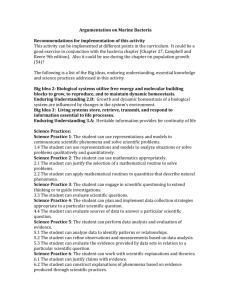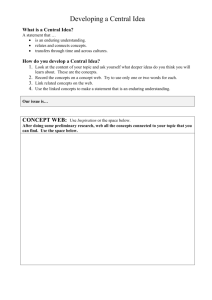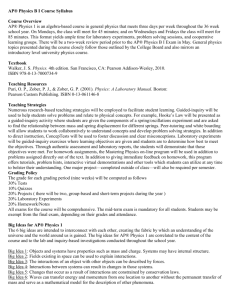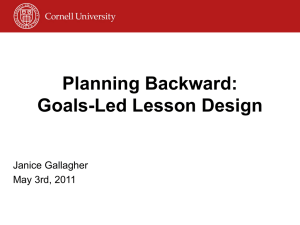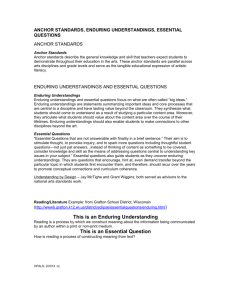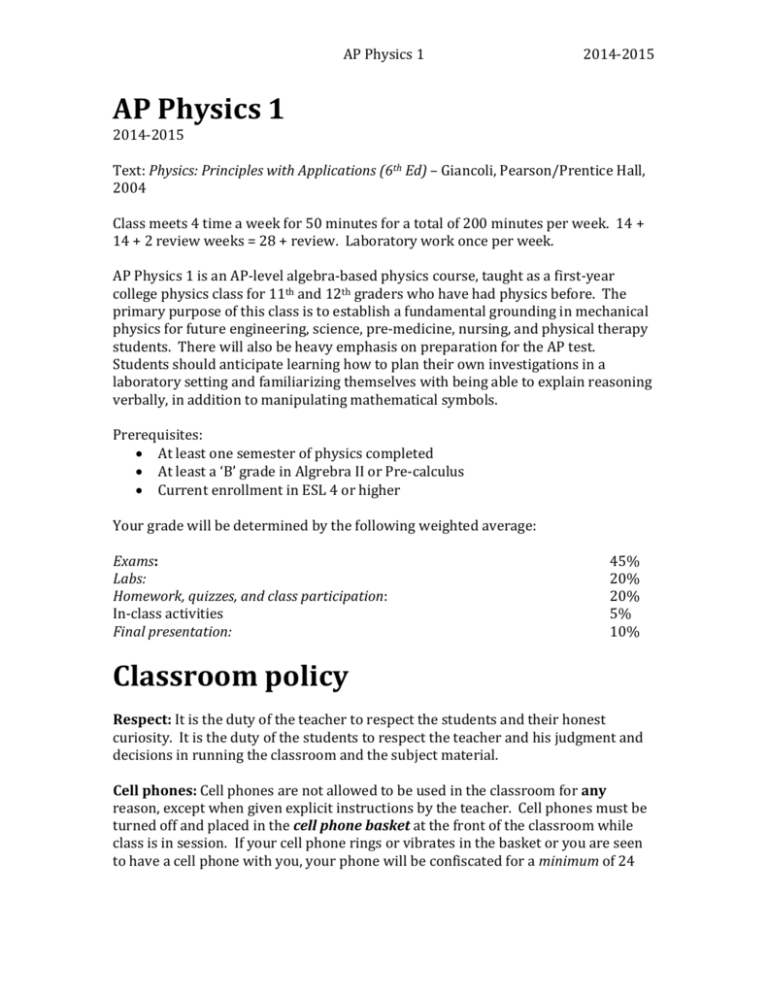
AP Physics 1
2014-2015
AP Physics 1
2014-2015
Text: Physics: Principles with Applications (6th Ed) – Giancoli, Pearson/Prentice Hall,
2004
Class meets 4 time a week for 50 minutes for a total of 200 minutes per week. 14 +
14 + 2 review weeks = 28 + review. Laboratory work once per week.
AP Physics 1 is an AP-level algebra-based physics course, taught as a first-year
college physics class for 11th and 12th graders who have had physics before. The
primary purpose of this class is to establish a fundamental grounding in mechanical
physics for future engineering, science, pre-medicine, nursing, and physical therapy
students. There will also be heavy emphasis on preparation for the AP test.
Students should anticipate learning how to plan their own investigations in a
laboratory setting and familiarizing themselves with being able to explain reasoning
verbally, in addition to manipulating mathematical symbols.
Prerequisites:
At least one semester of physics completed
At least a ‘B’ grade in Algrebra II or Pre-calculus
Current enrollment in ESL 4 or higher
Your grade will be determined by the following weighted average:
Exams:
Labs:
Homework, quizzes, and class participation:
In-class activities
Final presentation:
45%
20%
20%
5%
10%
Classroom policy
Respect: It is the duty of the teacher to respect the students and their honest
curiosity. It is the duty of the students to respect the teacher and his judgment and
decisions in running the classroom and the subject material.
Cell phones: Cell phones are not allowed to be used in the classroom for any
reason, except when given explicit instructions by the teacher. Cell phones must be
turned off and placed in the cell phone basket at the front of the classroom while
class is in session. If your cell phone rings or vibrates in the basket or you are seen
to have a cell phone with you, your phone will be confiscated for a minimum of 24
AP Physics 1
2014-2015
hours. For example, loss of a phone on a Friday will result in losing the phone for
the entire weekend.
Food and drink: Food and drink are not permitted in the physics classroom.
Exception: you are permitted to bring drinks if brought in a reusable sealable
container.
Trash: Students are expected to dispose of their trash and garbage. If you leave
graded assignments in the classroom after class time, those assignments will be
changed to 0 credit.
Class participation: Students are expected to improve the classroom setting. Raise
your hand to ask a question. Talking out of turn – including talking while the teacher
is talking and talking without raising your hand – is NOT permitted. Each time a
student talks out of turn, (s)he loses 1 point from his/her class participation grade.
All relevant questions about the subject (e.g. “Can you explain the last step in that
problem?”) are highly encouraged. It can take bravery to admit that you do not
understand and almost always another student has the same question and is
relieved that you asked. Private questions (e.g. “I have a question about the grade
on my test”, “Do you have my homework?”) should be saved for after class.
Comments about the class (e.g. “This test was too hard.”) should always be
discussed in private, out of respect for the classroom environment.
Absences/missing class: All work due to unexcused absences will be given 0
credit. All work missed due to excused absences can be made up. Students are
responsible for making sure they get missed assignments and tests. A good idea is
to ask the teacher during free time, “What did I miss?” The due dates for missed
work will be decided by the teacher; however, do not expect any additional time to
prepare for missed tests or quizzes. Be ready on the day you return.
Supplies: Students will need a physics folder to keep graded physics assignments.
Students will need a physics spiral notebook where they can take class notes (see:
Tests). Students will need a lab notebook, to keep their labs in. Lab notebooks will
be given at beginning of the year. Being ready for class also means having
something to write with. Pencil or mechanical pencil is highly recommended.
Cheating: Cheating (copying another student) in test and quizzes is absolutely
prohibited. Cheating will result in a 0 score and disciplinary sanctions for the
person cheating. Disciplinary sanctions will also result for the person who helped
the student cheat.
Name on paper: Put your name on your assignments. Assignments with no name
on them will be given half credit if I can find out who they belong to. If I cannot find
out whom an assignment belongs to, 0 credit will be given.
AP Physics 1
2014-2015
Homework and Quizzes
Homework assignments are required for this class. Homework due dates will be
posted to the class website: http://www.examplewebsite.com. Students are
permitted to work together, but each student must be able to reproduce the work on
his/her own. For this reason, homework quizzes will be given. Late homework is
accepted up to one day late at 50% credit. Homework will not be accepted that is
more than 24 hours late. Unless otherwise stated, all homework will be due at the
end of the school day at 5pm. Homework will be graded on a 2-point scale:
0 points X
1 point √2 points √
Did not do, no effort
Partially completed. Some effort
Completed. Showed effort.
Quizzes will be graded on a 4-point scale:
1
2
3
4
Attempted and has name.
Some correct work and understanding
Minor mistake (e.g. units missing)
Perfect
Tests
Every 1 or 2 units, there will be a test. All tests will be open notes! This means you
are allowed to use your notes in your spiral notebooks on all regular tests. Take
good notes! After each test, you have the option of redoing all missed points for half
credit. For example, if you get a 80% on the test, it is possible to redo the missed
points and get a 90%. Test redos must be done on the same test using a different
color. No redo credit will be given without your original test.
Final presentation
Towards the end of the school year, you will be required to choose a physics-related
topic that interests you to research. Results will be given in the form of a 15-minute
oral presentation to the class. PowerPoint is optional but not required.
Presentations will be graded on (in descending order of importance): depth of
research, clarity of presentation, style of presentation, and scores of the above
elements as given by classmates. More information will be given later in the school
year.
Grades
Grades will be determined based on a combination of a curve and an absolute scale.
A good guide:
A
B
Excellent understanding of material and
details. Top ~15% of the class.
Good understanding. Above average in
AP Physics 1
C
D
F
2014-2015
class.
Some understanding. Below average in
class.
Problems with basic concepts. Cannot do
simple problems. Bottom ~15% of class.
Missing work.
Very little understanding of basic concepts.
Significantly behind the rest of the class.
Missing most assignments.
Calendar:
I.
Kinematics(4 weeks) Standards 3.A.1, 1.A.1, 4.A.1
a.
b.
c.
d.
e.
f.
g.
h.
i.
Vectors
Vector algebra
Vector components
Coordinate systems
Displacement
Velocity
Acceleration
Motion in one dimension
Motion in two dimensions
i. Projectile motion
II. Newton’s Laws of Motion (5 weeks) Standards:
1.C.1, 1.C.2, 1.C.3, 2.B.1, 2.B.2, 3.A, 3.B, 3.C, 4.A
a. Static equilibrium (1st law)
b. Dynamics of a single object (2nd law)
c. Systems of two or more objects (3rd law)
III. Work, Energy, Power (4 weeks)1.D, 3.E, 4.C, 5.A, 5.B
a. Work and the Work-Energy theorem 3.E
i. Real-world Activity Analysis: Catching a Falling
Child from a Window
Prediction: What will happen to the man who catches the
child? What will the force on him be? How does this force
depend on the height of the window, mass of the child, and
distance the arms move?
AP Physics 1
2014-2015
b. Forces and potential energy 2.E.1.1
c. Conservation of energy
d. Power
i. Debate: Who will win a race: a motorcycle, a
car, or an airplane?
What the factors in a vehicle that contribute to its victory in
race? What are the order of magnitude differences in these
factors between these three vehicles? Make an argument for the
importance of mass, volume, cross-sectional area, coefficient of
drag, power, force, etc…
ii. Real-world application: Generating electrical
power safely and cleanly
Making basic assumptions about the population growth of the
world, estimate future power needs of the world’s population.
Determine sources of power available, and evaluate the best
choices based on concerns for financial, human, an
environmental cost.
IV. Linear momentum (3 weeks) 3.D, 4.B, 5.A, 5.D, 5.D.3
a. Center of mass
b. Impulse and momentum
c. Conservation of linear momentum
V. Circular motion and rotation (4 weeks)3.C.1,
3.E.1, 3.F, 4.D, 5.B, 5.E
a. Uniform circular motion (constant speed)
b. Torque and rotational statics (Newton’s 1st law for
rotation)
c. Rotational kinematics and dynamics (Newton’s 2nd
law for rotation)
d. Rotational kinetic energy
e. Angular momentum and conservation
VI. Oscillations and gravitation (4 weeks) Standards
1.C.1, 1.C.3, 2.B, 3.B, 3.C, 3.E, 3.F, 3.G.1, 4.D, 5.A, 5.B, 5.E
a. Simple harmonic motion (dynamics and energy)
i. Mass on a spring
ii. Pendulum and other oscillations
b. Newton’s law of gravity
c. Orbits of planets and satellites
AP Physics 1
2014-2015
i. Circular
VII. Waves (2 weeks)6.A, 6.B, 6.C, 6.D
a. Traveling waves
i. Mechanical Waves
ii. Sound
b. Wave propagation
c. Standing waves 6.D.3
d. Superposition
VIII. Electric charge and circuits (2 weeks)
a. Charge and Coulomb’s Law 1.B, 1.E.2, 2.C, 3.C, 4.E,4,5.A, 5.C
i. Charge is a conserved quantity 5.C
b. Electric potential 2.E
c. Circuits:
i. Ohm’s Law 1.E
ii. Combining resistors
iii. Kirchoff’s laws 5.B.9, 5.C.3
iv. Power dissipated in a circuit
IX. AP Exam review
X. Projects and presentations (must show at least
two enduring understandings. Sample presentation:
Special relativity in The Planet of the Apes. LO 1.D.3.1,
L.O.5.A.2.1, EK 5.A.5 Details below.)
Labs
An important part of this class involves laboratory work, which involves conducting
experiments, collecting data, doing analysis on the data, and submitting all data and
analysis in the form of a lab report, due the Monday after lab day. Labs will occupy
25% of class time, which is one day per week. All data and lab reports should be
kept in your designated physics lab notebooks, which you’ll be given at the start of
the year. Each lab report should start on a new page in your lab notebook and
should include the following sections:
1. Abstract
The abstract should include the title of the lab and a one or two sentence
statement summarizing what this lab is about.
2. Background/theory/hypothesis
AP Physics 1
2014-2015
What physical principle is being tested? What predictions does the theory
make?
3. Procedure
Describe how the experiment was done. If someone else wanted to repeat the
experiment to confirm your results, how would they do it? What would they
need to know?
4. Data
Actual data recorded.
5. Analysis and discussion
Interpret and analyze your data in this section. Make sure all axes are labeled
and numbered with proper units!
How do your results compare with the theory in section 2? If you’re are trying to
𝑎𝑐𝑡𝑢𝑎𝑙−𝑝𝑟𝑒𝑑𝑖𝑐𝑡𝑒𝑑
measure something, make sure to include % error ( | 𝑝𝑟𝑒𝑑𝑖𝑐𝑡𝑒𝑑 |x100% ).
Comment on whether your result is close or far away from the expected result.
List any sources of error (e.g. friction due to air, limitations of equipment) that
could explain the difference between your result and the expected result. For
each possible source of error, which direction would the error bias the result (i.e.
would each make the result larger or smaller)? In your own judgment, was your
result convincing proof of the physical principle? Was your result too far from
what the theory predicted? Reminder: having a result with a large error is not
wrong if you can explain it! Report what the data says, NOT what you want the
data to say!
There is no recommended length for each lab report. Include everything that you
think is important and say it in the smallest amount of space that you need.
Tentative* list of possible labs
Lab
Number
1
Name
Subject
World class runner: Guided-inquiry
1D Kinematics
2
Guided-inquiry: Determining g from motion on an
2D Kinematics
inclined plane
3
Guided-inquiry: Human-powered projectile motion
2D Kinematics
4
Open-inquiry: Friction and μ
Forces
5
Open-inquiry: Show that Work = Change in Kinetic
Work and energy
energy
AP Physics 1
2014-2015
6
Guided-inquiry: Collisions
Energy and momentum
7
Open-inquiry: Torque and angular acceleration
Rotational motion
8
Guided-inquiry: Determining g from a simple pendulum
Simple Harmonic Motion
9
Guided-inquiry: Predicting period of a mass-spring
Simple Harmonic Motion
system
10
Open-inquiry: g and the buoyancy force
Fluids
11
Guided-inquiry: Drawing equipotential lines
Electricity
12
Guided-inquiry: Ohm’s Law: Combining resistors
Electricity
13
Guided-inquiry: Speaker lab: Finding cancellation points
Waves
14
Guided-inquiry: Doppler effect of a car horn
Waves
Lab summaries:
1. Guided-inquiry: World-Class Runner: Determine from experiment whether a
runner accelerates at a constant rate before reaching a constant velocity,
using sidewalk chalk and timers. SPs: 1, 2, 3, 4, 5, 6, 7
2. Guided-inquiry: Determining g from motion on an inclined plane: Use
Vernier ramps and photogate sensors to determine the acceleration due to
gravity on an inclined plane. SPs: 1, 2, 3, 4, 5, 6
3. Guided-inquiry: Human-powered projectile motion: Use trundlewheels and
timers to measure x and t. Determine v0x, v0y, θ, v0. SPs: 1, 2, 3, 4, 5, 6
4. Open-inquiry: Friction and μ: Use the Dual-Range Force Sensor and a scale to
graph the relationship between normal force and frictional force and determine μ
SPs: 1, 2, 3, 4, 5, 6
5. Open-inquiry lab: Show that Work = Change in Kinetic energy or that Energy
is Conserved. Using the equipment available, find a way to test the hypothesis
of the Work-Energy Theorem or the Conservation of Energy SPs: 1, 2, 3, 4, 5,
6
6. Guided-inquiry: Collisions. Using photogates, test the conservation of
momentum for Vernier carts. SPs: 1, 2, 3, 5, 6
7. Open-inquiry: Torque and angular acceleration. Using Vernier angular
motion sensors, find a way to test whether torque is proportional to angular
acceleration, and what the constant of proportionality is. SPs: 1, 2, 3, 4, 5, 6, 7
AP Physics 1
2014-2015
8. Guided-inquiry: Determining g from a simple pendulum. Using Vernier
angular motion sensors, measure the period of a simple pendulum. Use this
information to find g, the acceleration due to gravity. SPs: 1, 2, 3, 5, 6
9. Guided-inquiry: Predicting period of a mass-spring system: Predict the
period of a mass-spring system, based on mass and the spring constant.
Using the Vernier Dual-Range Force Sensors, measure the period and
compare. . SPs: 1, 2, 3, 5, 6
10. Open-inquiry: g and the buoyancy force: Using the Dual-Range Force Sensor
and a graduated beaker, measure how the buoyancy force varies with the
displaced volume of water. Use this information to find g, the acceleration
due to gravity. SPs: 1, 2, 3, 4, 5, 6
11. Guided-inquiry: Drawing equipotential lines: Using conductive paper and a
voltmeter, draw the equipotential lines of various electrode configurations.
SPs: 1, 3, 6
12. Guided-inquiry: Ohm’s Law: Combining resistors: Combine resistors in series
and parallel in various configurations. See if the new combination
resistances are as predicted by series and parallel combination laws. SPs: 1,
2, 3, 5, 6
13. Guided-inquiry: Speaker lab: Finding cancellation points: Using a tone
generator, find locations of local minimum from destructive interference.
Use this information to determine speed of sound in air. SPs: 1, 2, 3, 4, 5, 6, 7
14. Guided-inquiry: Doppler effect of a car horn: Using data gathered with a
spectroscope, determine the speed of a car from its Doppler shift. SPs: 1, 2, 3,
5, 6
Homework and Quizzes
Homework is the most essential part of learning. Students are permitted to work
together, but each student must be able to reproduce the work on his/her own. For
this reason, homework quizzes will be given. Homework credit will partially be
based on the corresponding quiz score. Late homework is accepted up to one day
late at 50% credit.
Final presentation
Towards the end of the school year, you will be required to choose a physics-related
topic that interests you to research. Results will be given in the form of a 20-minute
oral presentation to the class. PowerPoint is optional but not required.
Presentations will be graded on (in descending order of importance): depth of
research, clarity of presentation, style of presentation, and scores of the above
elements as given by classmates. A list of suggested topics will be given. You may
also choose your own topic, but the topic must be connected to physics by at least
two of the following enduring understandings:
AP Physics 1
Enduring Understanding 1.A: The internal structure of
a system determines many properties of the system.
Enduring Understanding 1.B: Electric charge is
a property of an object or system that affects its
interactions with other objects or systems containing
charge.
Enduring Understanding 1.C: Objects and systems
have properties of inertial mass and gravitational mass
that are experimentally verified to be the same and that
satisfy conservation principles.
Enduring Understanding 1.D: Classical mechanics
cannot describe all properties of objects.
Enduring Understanding 1.E: Materials have many
macroscopic properties that result from the arrangement
and interactions of the atoms and molecules that make
up the material.
Enduring Understanding 2.A: A field associates a
value of some physical quantity with every point in
space. Field models are useful for describing interactions
that occur at a distance (long–range forces) as well as a
variety of other physical phenomena
Enduring Understanding 2.B: A gravitational field is
caused by an object with mass.
Enduring Understanding 3.A: All forces share
certain common characteristics when considered
by observers in inertial reference frames.
Enduring Understanding 3.B: Classically, the
acceleration of an object interacting with other objects
can be predicted by using
Enduring Understanding 3.C: At the macroscopic level,
forces can be categorized as either long–range (action–
at–a–distance) forces or contact forces.
Enduring Understanding 3.D: A force exerted on an
object can change the momentum of the object.
Enduring Understanding 3.E: A force exerted on an
object can change the kinetic energy of the object.
Enduring Understanding 3.F: A force exerted on an
object can cause a torque on that object.
Enduring Understanding 3.G: Certain types of forces
are considered fundamental
Enduring Understanding 4.A: The acceleration of the
center of mass of a system is related to the net force
exerted on the system, where a=Sum(F)/m
Enduring Understanding 4.B: Interactions with
other objects or systems can change the total linear
momentum of a system.
Enduring Understanding 4.C: Interactions with other
objects or systems can change the total energy of a
system.
Enduring Understanding 4.D: A net torque exerted
on a system by other objects or systems will change the
angular momentum of the system.
Enduring Understanding 5.A: Certain quantities
are conserved, in the sense that the changes of those
2014-2015
AP Physics 1
quantities in a given system are always equal to the
transfer of that quantity to or from the system by all
possible interactions with other systems.
Enduring Understanding 5.B: The energy of a system
is conserved.
Enduring Understanding 5.C: The electric charge of a
system is conserved.
Enduring Understanding 5.D: The linear momentum of
a system is conserved.
Enduring Understanding 5.E: The angular momentum
of a system is conserved.
Enduring Understanding 5.F: Classically, the mass of a
system is conserved.
Enduring Understanding 5.G: Nucleon number is
conserved.
Enduring Understanding 6.A: A wave is a traveling
disturbance that transfers energy and momentum.
Enduring Understanding 6.B: A periodic wave is one
that repeats as a function of both time and position
and can be described by its amplitude, frequency,
wavelength, speed, and energy.
Enduring Understanding 6.C: Only waves exhibit
interference and diffraction
Enduring Understanding 6.D: Interference and
superposition lead to standing waves and beats.
2014-2015

